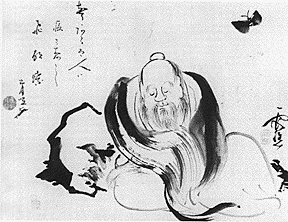550-450 BCE: Laozi, first great Daoist
350-250 BCE: Zhuangzi, second great Daoist
Daoism: Laozi and Zhuangzi
- Laozi and Zhuangzi, the founding figures of Daoism
Laozi: The Old Master
- The Popularity of the Laozi
- The legend of the Book of Laozi, otherwise known as:
- The Daodejing (Book of the Way and the Power/Virtue)
- The emergence of the myriad things out of the unspoken Dao
- Oneness and Twoness: Yin and Yang Nonduality
- Activity and Receptivity; Light and Dark
- Differentiation and Oneness; Being and Nonbeing
- Peak and Valley; Male Principle and Female Principle
- Verse and the Expression of Daoist Philosophy
Zhuangzi: The Village Master

- The Book of Zhuangzi
- The Character Zhuangzi versus the Author Zhuangzi
- The Problem: Mental Static
- Too much thinking, wrong-headed thinking
- Great Understanding and Little Understanding (p. 32)
- Perspectivalism -> Dissolution of Boundaries -> Oneness (pp. 40-41, 44, 38)
- Living in the Dao: The Hinge and the Socket (p. 35)
- Populating the Dao:
- Cook Ding (pp. 45-46)
- Crippled Shu and the Madman of Chu (pp. 61-62)
- Woodworker Qing (p. 129)
- Three Uses of Language
- Logical Analysis: Beginning, This & That (pp. 38, 35)
- Language of Scale: Myth
- The Kun Fish and the Peng Bird (p. 23)
- The Quail and the Peng Bird (p. 25)
- Paradox (p. 38)
- Laozi (Lao Tzu) vs Zhuangzi (Chuang Tzu)
- Retreat from world vs Living in the world but not be of it
- Laozi: agrarian ideal - return to small farming communities
- Both emphasize Undoing, rather than Doing, but Zhuangzi is more internal than Laozi
